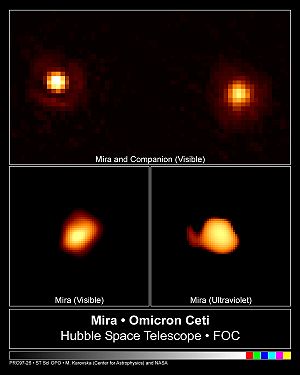- Mira B
-
 Hubble Space Telescope using Faint Object Camera red giant star Mira A (right), officially called Omicron Ceti in the constellation Cetus, and its companion on the left. Taken on December 11, 1995
Hubble Space Telescope using Faint Object Camera red giant star Mira A (right), officially called Omicron Ceti in the constellation Cetus, and its companion on the left. Taken on December 11, 1995
Mira B, also known as VZ Ceti, is the companion star to the variable star Mira. Suspected as early as 1918, it was visually confirmed in 1923 by Robert Grant Aitken, and has been observed more or less continually since then, most recently by the Chandra X-Ray Observatory.[1] Its orbit around Mira is poorly known; the most recent estimate listed in the Sixth Orbit Catalog of Visual Binary Stars gives an orbital period of roughly 500 years, with a periastron around the year 2285. Assuming the distance in the Hipparcos catalog and orbit are correct, Mira A and B are separated by an average of 100 AU.
Long-known to be erratically variable itself, its fluctuations seem to be related to its accretion of matter from Mira's stellar wind, which makes it a symbiotic star.[2][3]
Current research
In January 2007, astronomers at the Keck Observatory announced the discovery of a protoplanetary disk around Mira B. Discovered via infrared data, the disk is apparently derived from captured material from Mira itself; Mira B accretes as much as one percent of the matter lost by its primary. Though planetary formation is perhaps unlikely as long as the disk is in active accretion, it may proceed apace once Mira A completes its red giant phase and becomes a white dwarf remnant.
The new data suggest that Mira B is a normal main sequence star of spectral type K and roughly 0.7 solar masses, rather than a white dwarf as first envisioned.[4]
However, even more recently (2010) analysis of rapid optical brightness variations has indicated that Mira B is in fact a white dwarf.[5]
External links
- From the AAVSO Variable Star of the Month: Mira
- Sixth Orbit Catalog
- Chandra Photo Album, Mira press release
- Born Again Protoplanetary Disk Around Mira B
References
- ^ Robert Burnham, Jr., Burnham's Celestial Handbook, Vol. 1, (New York: Dover Publications, Inc., 1978), 637-8.
- ^ Ibid., 638.
- ^ James Kaler, The Hundred Greatest Stars, (New York: Copernicus Books, 2002), 121.
- ^ "First Planet-Forming Disk Found in the Environment of a Dying Star." Accessed 1/10/07. http://www.keckobservatory.org/article.php?id=99
- ^ Sokoloski; Lars Bildsten (2010). "Evidence for the White Dwarf Nature of Mira B". arXiv:1009.2509v1 [astro-ph.SR].
Bayer α (Menkar) • β (Deneb Kaitos, Diphda) • γ (Kaffaljidhma) • δ • ε • ζ (Baten Kaitos) • η • θ • ι • κ1 • λ • μ • ν • ο A (Mira) • ο B (VZ Ceti) • π • ρ • σ • τ • χFlamsteed 1 • 2 • 3 • 6 • 7 • 8 (ι) • 9 • 10 • 11 • 12 • 13 • 14 • 15 • 16 (β, Deneb Kaitos, Diphda) • 18 • 20 • 21 • 25 • 26 • 27 • 28 • 29 • 30 • 31 (η) • 32 • 33 • 34 • 35 • 36 • 37 • 38 • 39 • 40 • 41 • 42 • 43 • 44 • 45 (θ) • 46 • 47 • 48 • 49 • 50 • 52 (τ) • 53 (χ) • 55 (ζ, Baten Kaitos) • 57 • 58 • 61 • 62 • 63 • 64 • 66 • 67 • 68 A(ο A, Mira) • 68 B(ο B, VZ Ceti) • 69 • 70 • 71 • 72 (ρ) • 75 • 76 (σ) • 77 • 78 (ν) • 79 • 80 • 81 • 82 (δ) • 83 (ε) • 84 • 86 (γ, Kaffaljidhma) • 87 (μ) • 89 (π) • 91 (λ) • 92 (α, Menkar) • 93 • 94 • 95 • 96 (κ1) • 25 AriNearby WISE 0254+0223List Categories:- Binary stars
- Mira variables
- White dwarfs
- Cetus constellation
- Bayer objects
- Objects named with variable star designations
Wikimedia Foundation. 2010.
